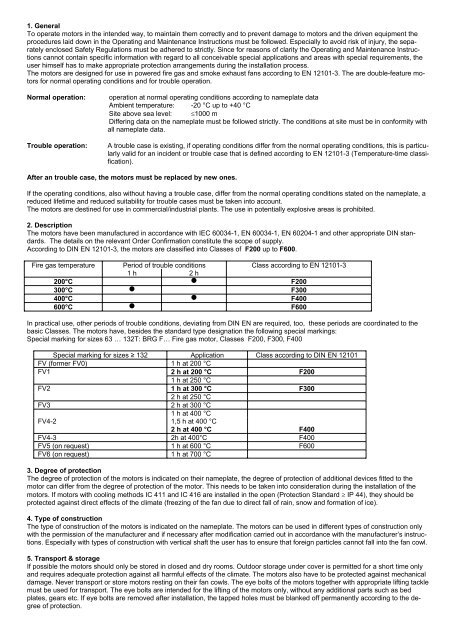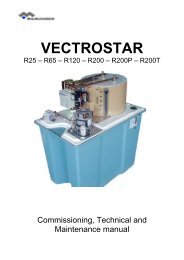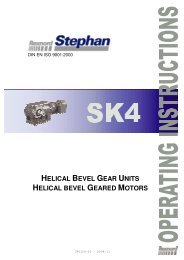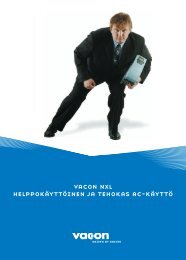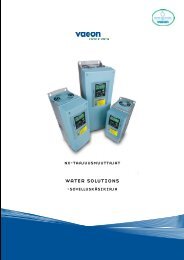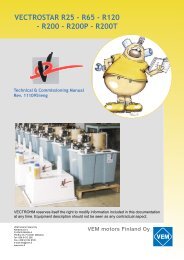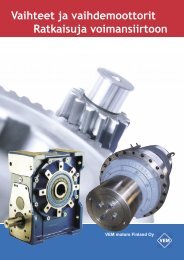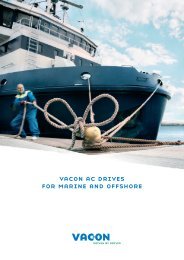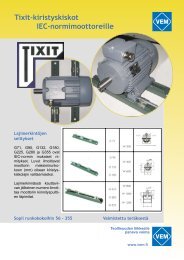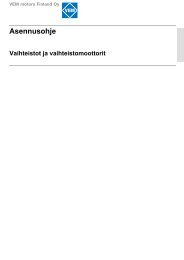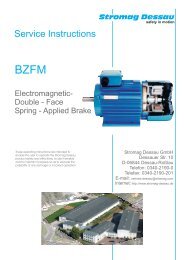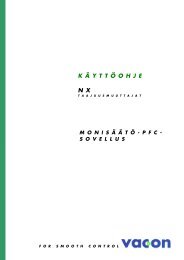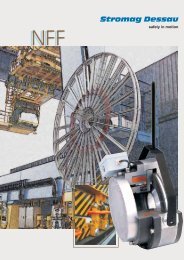Create successful ePaper yourself
Turn your PDF publications into a flip-book with our unique Google optimized e-Paper software.
1. General<br />
To operate motors in the intended way, to maintain them correctly and to prevent damage to motors and the driven equipment the<br />
procedures laid down in the Operating and Maintenance Instructions must be followed. Especially to avoid risk of injury, the separately<br />
enclosed Safety Regulations must be adhered to strictly. Since for reasons of clarity the Operating and Maintenance Instructions<br />
cannot contain specific information with regard to all conceivable special applications and areas with special requirements, the<br />
user himself has to make appropriate protection arrangements during the installation process.<br />
The motors are designed for use in powered fire gas and smoke exhaust fans according to EN 12101-3. The are double-feature motors<br />
for normal operating conditions and for trouble operation.<br />
Normal operation: operation at normal operating conditions according to nameplate data<br />
Ambient temperature: -20 °C up to +40 °C<br />
Site above sea level: �1000 m<br />
Differing data on the nameplate must be followed strictly. The conditions at site must be in conformity with<br />
all nameplate data.<br />
Trouble operation: A trouble case is existing, if operating conditions differ from the normal operating conditions, this is particularly<br />
valid for an incident or trouble case that is defined according to EN 12101-3 (Temperature-time classification).<br />
After an trouble case, the motors must be replaced by new ones.<br />
If the operating conditions, also without having a trouble case, differ from the normal operating conditions stated on the nameplate, a<br />
reduced lifetime and reduced suitability for trouble cases must be taken into account.<br />
The motors are destined for use in commercial/industrial plants. The use in potentially explosive areas is prohibited.<br />
2. Description<br />
The motors have been manufactured in accordance with IEC 60034-1, EN 60034-1, EN 60204-1 and other appropriate DIN standards.<br />
The details on the relevant Order Confirmation constitute the scope of supply.<br />
According to DIN EN 12101-3, the motors are classified into Classes of F200 up to F600.<br />
Fire gas temperature Period of trouble conditions Class according to EN 12101-3<br />
1 h 2 h<br />
200°C � ��� F200<br />
300°C ��� � F300<br />
400°C � ��� F400<br />
600°C ��� � F600<br />
In practical use, other periods of trouble conditions, deviating from DIN EN are required, too, these periods are coordinated to the<br />
basic Classes. The motors have, besides the standard type designation the following special markings:<br />
Special marking for sizes 63 … 132T: BRG F… Fire gas motor, Classes F200, F300, F400<br />
Special marking for sizes � 132 Application Class according to DIN EN 12101<br />
FV (former FV0) 1 h at 200 °C<br />
FV1 2 h at 200 °C F200<br />
1 h at 250 °C<br />
FV2 1 h at 300 °C F300<br />
2 h at 250 °C<br />
FV3 2 h at 300 °C<br />
1 h at 400 °C<br />
FV4-2 1,5 h at 400 °C<br />
2 h at 400 °C F400<br />
FV4-3 2h at 400°C F400<br />
FV5 (on request) 1 h at 600 °C F600<br />
FV6 (on request) 1 h at 700 °C<br />
3. Degree of protection<br />
The degree of protection of the motors is indicated on their nameplate, the degree of protection of additional devices fitted to the<br />
motor can differ from the degree of protection of the motor. This needs to be taken into consideration during the installation of the<br />
motors. If motors with cooling methods IC 411 and IC 416 are installed in the open (Protection Standard � IP 44), they should be<br />
protected against direct effects of the climate (freezing of the fan due to direct fall of rain, snow and formation of ice).<br />
4. Type of construction<br />
The type of construction of the motors is indicated on the nameplate. The motors can be used in different types of construction only<br />
with the permission of the manufacturer and if necessary after modification carried out in accordance with the manufacturer’s instructions.<br />
Especially with types of construction with vertical shaft the user has to ensure that foreign particles cannot fall into the fan cowl.<br />
5. Transport & storage<br />
If possible the motors should only be stored in closed and dry rooms. Outdoor storage under cover is permitted for a short time only<br />
and requires adequate protection against all harmful effects of the climate. The motors also have to be protected against mechanical<br />
damage. Never transport or store motors resting on their fan cowls. The eye bolts of the motors together with appropriate lifting tackle<br />
must be used for transport. The eye bolts are intended for the lifting of the motors only, without any additional parts such as bed<br />
plates, gears etc. If eye bolts are removed after installation, the tapped holes must be blanked off permanently according to the degree<br />
of protection.


